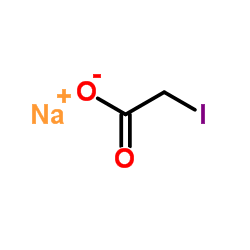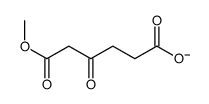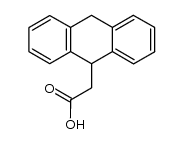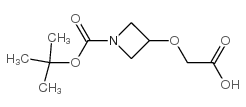sodiumiodoacetate

sodiumiodoacetate structure
|
Common Name | sodiumiodoacetate | ||
|---|---|---|---|---|
| CAS Number | 305-53-3 | Molecular Weight | 207.930 | |
| Density | N/A | Boiling Point | 262.1ºC at 760mmHg | |
| Molecular Formula | C2H2INaO2 | Melting Point | 208 °C (dec.)(lit.) | |
| MSDS | Chinese USA | Flash Point | 112.3ºC | |
| Symbol |


GHS05, GHS06 |
Signal Word | Danger | |
| Name | sodium,2-iodoacetate |
|---|---|
| Synonym | More Synonyms |
| Boiling Point | 262.1ºC at 760mmHg |
|---|---|
| Melting Point | 208 °C (dec.)(lit.) |
| Molecular Formula | C2H2INaO2 |
| Molecular Weight | 207.930 |
| Flash Point | 112.3ºC |
| Exact Mass | 207.899704 |
| PSA | 40.13000 |
| InChIKey | AGDSCTQQXMDDCV-UHFFFAOYSA-M |
| SMILES | O=C([O-])CI.[Na+] |
| Storage condition | −20°C |
| Water Solubility | methanol: 0.1 M at 20 °C, clear, colorless |
Synonym:Sodium iodoacetate; sodium monoiodoacetat Section 2 - COMPOSITION, INFORMATION ON INGREDIENTS
Risk Phrases: None Listed. Section 3 - HAZARDS IDENTIFICATION EMERGENCY OVERVIEW
Hygroscopic (absorbs moisture from the air).The toxicological properties of this material have not been fully investigated. Potential Health Effects Eye: No information regarding eye irritation and other potential effects was found. Skin: No information regarding skin irritation and other potential effects was found. Ingestion: The toxicological properties of this substance have not been fully investigated. Inhalation: The toxicological properties of this substance have not been fully investigated. Inhalation of dust may cause respiratory tract irritation. Chronic: No information found. Section 4 - FIRST AID MEASURES Eyes: Immediately flush eyes with plenty of water for at least 15 minutes, occasionally lifting the upper and lower eyelids. Get medical aid immediately. Skin: Get medical aid. Flush skin with plenty of water for at least 15 minutes while removing contaminated clothing and shoes. Ingestion: If victim is conscious and alert, give 2-4 cupfuls of milk or water. Never give anything by mouth to an unconscious person. Get medical aid. Inhalation: Remove from exposure and move to fresh air immediately. If not breathing, give artificial respiration. If breathing is difficult, give oxygen. Get medical aid. Notes to Physician: Section 5 - FIRE FIGHTING MEASURES General Information: As in any fire, wear a self-contained breathing apparatus in pressure-demand, MSHA/NIOSH (approved or equivalent), and full protective gear. Extinguishing Media: In case of fire, use water, dry chemical, chemical foam, or alcohol-resistant foam. Section 6 - ACCIDENTAL RELEASE MEASURES General Information: Use proper personal protective equipment as indicated in Section 8. Spills/Leaks: Sweep up, then place into a suitable container for disposal. Avoid generating dusty conditions. Section 7 - HANDLING and STORAGE Handling: Wash thoroughly after handling. Use with adequate ventilation. Minimize dust generation and accumulation. Avoid contact with eyes, skin, and clothing. Keep container tightly closed. Avoid ingestion and inhalation. Storage: Store in a tightly closed container. Store in a cool, dry, well-ventilated area away from incompatible substances. Section 8 - EXPOSURE CONTROLS, PERSONAL PROTECTION Engineering Controls: Use adequate ventilation to keep airborne concentrations low. Exposure Limits CAS# 305-53-3: Personal Protective Equipment Eyes: Wear appropriate protective eyeglasses or chemical safety goggles as described by OSHA's eye and face protection regulations in 29 CFR 1910.133 or European Standard EN166. Skin: Wear appropriate protective gloves to prevent skin exposure. Clothing: Wear appropriate protective clothing to prevent skin exposure. Respirators: Follow the OSHA respirator regulations found in 29 CFR 1910.134 or European Standard EN 149. Use a NIOSH/MSHA or European Standard EN 149 approved respirator if exposure limits are exceeded or if irritation or other symptoms are experienced. Section 9 - PHYSICAL AND CHEMICAL PROPERTIES Physical State: Powder Color: yellow Odor: None reported. pH: Not available. Vapor Pressure: Not available. Viscosity: Not available. Boiling Point: Not available. Freezing/Melting Point: 208.00 - 210.00 deg C Autoignition Temperature: Not available. Flash Point: 208 deg C ( 406.40 deg F) Explosion Limits, lower: Not available. Explosion Limits, upper: Not available. Decomposition Temperature: 208 deg C Solubility in water: soluble Specific Gravity/Density: Molecular Formula: C2H2IO2Na Molecular Weight: 207.93 Section 10 - STABILITY AND REACTIVITY Chemical Stability: Stable under normal temperatures and pressures. Conditions to Avoid: Incompatible materials, dust generation, moisture. Incompatibilities with Other Materials: Oxidizing agents Hazardous Decomposition Products: Carbon monoxide, carbon dioxide, toxic fumes of sodium oxide, hydrogen iodide, iodine. Hazardous Polymerization: Has not been reported. Section 11 - TOXICOLOGICAL INFORMATION RTECS#: CAS# 305-53-3: AI3675000 LD50/LC50: CAS# 305-53-3: Oral, mouse: LD50 = 83 mg/kg. Carcinogenicity: Iodoacetic acid, sodium salt - Not listed by ACGIH, IARC, or NTP. Other: See actual entry in RTECS for complete information. Section 12 - ECOLOGICAL INFORMATION Section 13 - DISPOSAL CONSIDERATIONS Dispose of in a manner consistent with federal, state, and local regulations. Section 14 - TRANSPORT INFORMATION IATA Shipping Name: TOXIC SOLID, ORGANIC, N.O.S.* Hazard Class: 6.1 UN Number: 2811 Packing Group: III IMO Shipping Name: TOXIC SOLID, ORGANIC, N.O.S. Hazard Class: 6.1 UN Number: 2811 Packing Group: III RID/ADR Shipping Name: TOXIC SOLID, ORGANIC, N.O.S. Hazard Class: 6.1 UN Number: 2811 Packing group: III Section 15 - REGULATORY INFORMATION European/International Regulations European Labeling in Accordance with EC Directives Hazard Symbols: Not available. Risk Phrases: Safety Phrases: S 22 Do not breathe dust. S 24/25 Avoid contact with skin and eyes. S 36/37/39 Wear suitable protective clothing, gloves and eye/face protection. S 45 In case of accident or if you feel unwell, seek medical advice immediately (show the label where possible). WGK (Water Danger/Protection) CAS# 305-53-3: No information available. Canada CAS# 305-53-3 is listed on Canada's DSL List. CAS# 305-53-3 is not listed on Canada's Ingredient Disclosure List. US FEDERAL TSCA CAS# 305-53-3 is listed on the TSCA inventory. SECTION 16 - ADDITIONAL INFORMATION N/A |
CHEMICAL IDENTIFICATION
HEALTH HAZARD DATAACUTE TOXICITY DATA
MUTATION DATA
|
| Symbol |


GHS05, GHS06 |
|---|---|
| Signal Word | Danger |
| Hazard Statements | H301-H315-H318-H335 |
| Precautionary Statements | P261-P280-P301 + P310-P305 + P351 + P338 |
| Personal Protective Equipment | Eyeshields;Faceshields;Gloves;type P2 (EN 143) respirator cartridges |
| Hazard Codes | T:Toxic; |
| Risk Phrases | R25;R36/37/38 |
| Safety Phrases | S26-S39-S45 |
| RIDADR | UN 2811 6.1/PG 1 |
| WGK Germany | 3 |
| RTECS | AI3675000 |
| Packaging Group | III |
| Hazard Class | 6.1(b) |
| HS Code | 2915900090 |
| Precursor 0 | |
|---|---|
| DownStream 10 | |
| HS Code | 2915900090 |
|---|---|
| Summary | 2915900090 other saturated acyclic monocarboxylic acids and their anhydrides, halides, peroxides and peroxyacids; their halogenated, sulphonated, nitrated or nitrosated derivatives VAT:17.0% Tax rebate rate:9.0% Supervision conditions:AB(certificate of inspection for goods inward,certificate of inspection for goods outward) MFN tariff:5.5% General tariff:30.0% |
|
Development of a quantitative mass spectrometry multi-attribute method for characterization, quality control testing and disposition of biologics.
MAbs 7 , 881-90, (2015) Regulatory agencies have recently recommended a Quality by Design (QbD) approach for the manufacturing of therapeutic molecules. A QbD strategy requires deep understanding at the molecular level of th... |
|
|
Thrombin-facilitated efflux of D-[3H]-aspartate from cultured astrocytes and neurons under hyponatremia and chemical ischemia.
Neurochem. Res. 39(7) , 1219-31, (2014) Thrombin effect increasing swelling-induced glutamate efflux was examined in cultured cortical astrocytes, cerebellar granule neurons (CGN), hippocampal and cortical neurons. Hypotonic glutamate efflu... |
|
|
Metformin inhibits growth of human glioblastoma cells and enhances therapeutic response.
PLoS ONE 10(4) , e0123721, (2015) High-grade gliomas, glioblastomas (GB), are refractory to conventional treatment combining surgery, chemotherapy, mainly temozolomide, and radiotherapy. This highlights an urgent need to develop novel... |
| lithium iodoacetate |
| sodiumiodoacetate |
| Sodium monoiodoacetate |
| EINECS 206-165-7 |
| Sodium iodacetate |
| USAF EK-6279 |
| 2-iodoacetic acid sodium salt |
| Iodoacetic acid sodium salt |
| Sodium iodoacetate |
| Iodoacetic acid,sodium salt |
| Acetic acid, 2-iodo-, sodium salt (1:1) |
| MFCD00002686 |
| Iodoacetate,sodium salt |
 CAS#:191542-37-7
CAS#:191542-37-7 CAS#:613-31-0
CAS#:613-31-0 CAS#:23825-24-3
CAS#:23825-24-3 CAS#:131581-34-5
CAS#:131581-34-5 CAS#:889952-83-4
CAS#:889952-83-4![2-[2-[2-(2-azidoethoxy)ethoxy]ethoxy]acetic acid structure](https://image.chemsrc.com/caspic/007/172531-37-2.png) CAS#:172531-37-2
CAS#:172531-37-2 CAS#:113815-00-2
CAS#:113815-00-2 CAS#:20057-39-0
CAS#:20057-39-0 CAS#:22245-55-2
CAS#:22245-55-2 CAS#:82243-05-8
CAS#:82243-05-8
